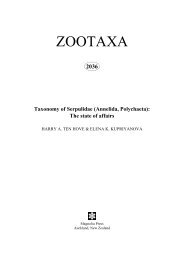You also want an ePaper? Increase the reach of your titles
YUMPU automatically turns print PDFs into web optimized ePapers that Google loves.
arranged rachillae, each rachilla subtended by an acute bracteole and with an axillary pulvinus; peduncles<br />
3.5(1.6–12.4) mm wide; peduncular bracts 26.3(16.5–34.0) cm long, broad, sparsely to densely covered with<br />
short, markedly swollen-based, diagonally oriented spines, these triangular in cross-section, whitish-brown<br />
proximally, brown distally, with tomentose margins, rarely spines few or absent; rachillae 15(5–37), glabrous<br />
or scarcely tomentose initially; proximal rachillae 7.4(3.3–13.0) cm long, 1.1(0.6–2.0) mm wide; stamens 5–<br />
6; fruits 16.4(11.2–23.5) mm long, 11.9(7.9–17.9) mm wide, the surfaces smooth, without any apparent<br />
subepidermal fibers; fruiting corollas less than one quarter as long as fruits, splitting irregularly into 3 lobes,<br />
the lobes often splitting again; endocarps globose to obovoid with rounded apices, the pores lateral, not<br />
equidistant, the sterile pores closer latitudinally.<br />
Distribution and habitat:—From 10°37’N–21°31’S and 35°09’–78°38’W in Trinidad, Venezuela, the<br />
Guianas, Brazil (including the Atlantic Coastal Forest), Colombia, Ecuador, Peru, and Bolivia at 205(0–1000)<br />
m elevation in a variety of habitats including lowland rainforest on terra firme, flooded forest, campina,<br />
restinga, or scrub forest near the sea (Fig. 11). Read (1979) also included the Lesser Antillean island of St.<br />
Vincent in the distribution of this species, but only one, sterile specimen from there has been seen. There is<br />
another specimen at P labelled “Martinique” but without more precise locality.<br />
FIGURE 11. Distribution maps of Desmoncus polyacanthos, D. prunifer, D. pumilus, and D. setosus.<br />
Taxonomic notes:—Desmoncus polyacanthos Martius was emended by Drude (1881) and excluded by<br />
Burret (1934). However there seems no reason for these designations. Martius’s (1823–1837) description and<br />
illustration, based on an extant type collected by Martius himself, perfectly represent this widespread species.<br />
A REVISION OF DESMONCUS (ARECACEAE)<br />
Phytotaxa 35 © 2011 <strong>Magnolia</strong> <strong>Press</strong> 41
















